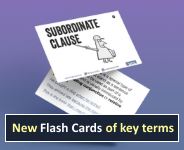Topic: Active and passive
These resources look at the contrast between active and passive voice, which offer different ways of presenting information. Compare the active clause The children decorated the cake with the passive clause The cake was decorated by the children. In the active the Subject indicates the 'doer' of the action of decorating (the children), while in the passive the Subject indicates what had the action 'done to' it (the cake).

